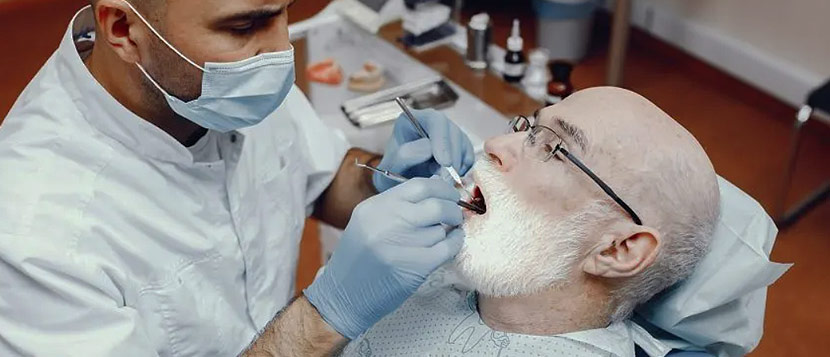Who Does a Dentist Go To, To Fix His Own Teeth?

Years ago, I read a story of a vacationing dentist visiting a one-dentist town on a small island off of Greece. The only local dentist in this town needed some dental work and he sat in his own chair while the visiting dentist fixed him up.
Back in the day, my childhood dentist practiced the “dental school” way his entire career. I got many silver/mercury fillings and he extracted two permanent teeth on one side to allow room for the others. Well, I ended up with a crooked bite and an off-centered smile.
Years later, I went to dental school and my indoctrination was intense. They taught me basically the same way dentists were taught some 30 to 40 years prior. Have you ever heard of gold foil? Well, it was tested by the state for my competency to practice dentistry here, but has long since been dropped. Most of what I was taught in dental school back then I’ve since thrown out of the front door.
I’ve had the privilege to study (at the feet) of the world’s greatest dentists, and one of my fellow classmates put on dental classes at the Ahwahnee Hotel in Yosemite for over three decades. He invited dentists from around the world to come and share their approach, and they got paid to do so all while visiting Yosemite National Park.
Advancements in dental treatment have improved as fast as or even faster than improvements in computers. New materials, new techniques, and explosive new understanding of the oral health have gone so far that I often say to my patients; ” If you can dream it, I can probably do it”.
Recently, I had some dental treatment done on myself by a dentist who had some advanced training and was recommended by a colleague. The office was tastefully designed with nice décor, but once I was in the chair, I realized it was lacking some of the latest technologies that I deem essential for dentists in this day and age.
Here are the four things that I consider absolutely necessary for me to practice dentistry.
1. Binocular Magnification, with an integrated head lamp projecting out between my eyes with a face shield. I can see things I never saw in the beginning of my career and with the head lamp I can see things even better without shadows. The face shield not only protects me from the splashing of liquids and debris from the mouth, but protects my patients as well.
2. Soft Tissue Laser: When prepping for crowns, this device sterilizes and cleans away gum tissue to obtain a better impression of the tooth. When the patient returns for cementation of the crown, the gums are a healthy pink color without much inflammation, and the patient generally reports no pain after treatment. I have not used the old dental school way of shoving a retraction cord between the tooth and gums, separating the tissue from the skull, for over 15 years. This cord is impregnated with epinephrine (adrenalin) to chemically shrink the tissues and stop the bleeding. This, in turn, can cause heart palpitations as it did to me. Epinephrine is the fight or flight secretion when we are scared.
3. Electric Handpiece (the dreaded drill): Originally the dental drill was powered by a spinning wheel or bicycle wheel. With the advent of electricity a motor was used to spin the cord that spun the drill. I remember my dentist using this on me and I used one of them while treating inmates at San Quentin.
In the mid 1960’s air powered dental drills were invented and are still widely used today. Because it spins so fast, a bearing is not possible, and in fact, air is the bearing that hold the impeller in place while it spins from 250 to 450 thousand RPMs. While spinning at the high RPMs, the drill shaft and thus the drill bit wobbles—so in effect it beats the tooth enamel in order to cut or remove tooth structure. The vibrations and noise (that most patients hate) is the results of using this type of dental drill. This action of beating the tooth also causes the increase temperature of the tooth and can cook the pulp (nerve). With that, the micro vibrations radiating up the dentist’s wrist and forearm increases the risk of carpal tunnel syndrome.
Then in the last decades the electric dental handpiece was developed which has a bearing that makes it smooth running and spins at a much slower RPM. When it cuts, it is more like a milling machine that does not vibrate, create heat, and is much quieter which is much more beneficial to both the patient and the dentist! 95 % of German dentists use the electric handpiece while only 5 % of American dentists use it. Why? It costs 30 times more. So, at my dental practice I choose kind dental treatment over office decor.
4. Local anesthetic: was first developed in the 1930’s. Lidocaine was synthesized from Novocain in the 1940’s of which the United States uses 10 tons of the drug annually. Because of the shortages during World War II, Lidocaine was not available until after the war was over. It took about ten years to train the dentists in the use of this most widely used local anesthetic (Oh No! Not the Shot!). Many different chemical versions are now available for different applications. Today I use a more potent anesthetic then Lidocaine so my patents can enjoy the lack of pain associated with dental treatments.
My recent visit? Well the dentist did have the binoculars and light, but the rest was disappointing. The placement of the retraction cord was painful and I still have pain post operatively in my gum, and the old-style air drill has left me with residual pain (cooked nerve).
I have increased empathy for my patient’s experience and will try my utmost to restore their oral health without the bad experiences or sequelae. ” So this begs the question: Which is more important- beautiful office decor or better dentistry?”
